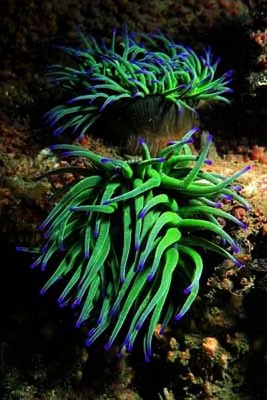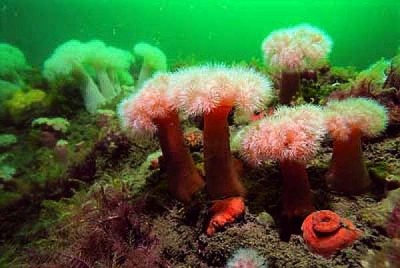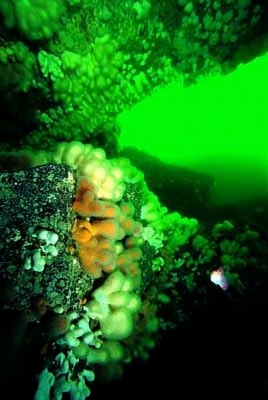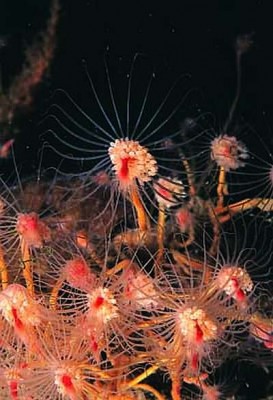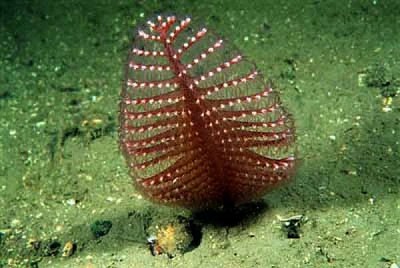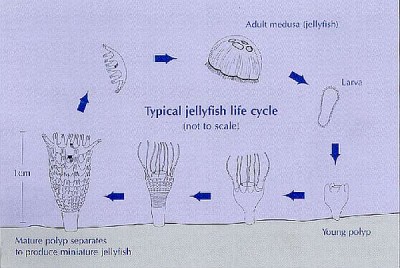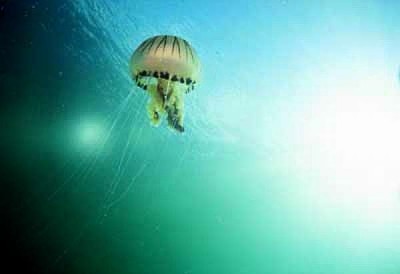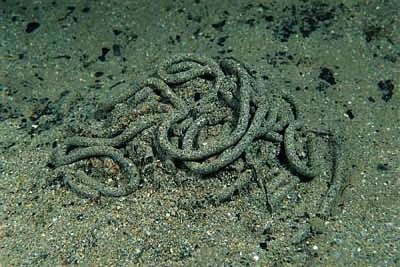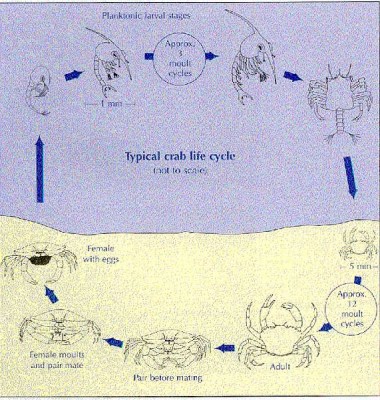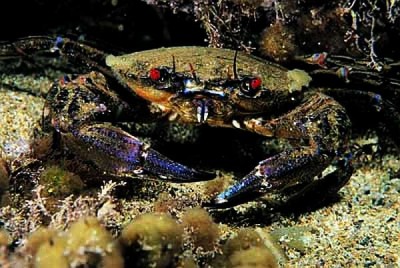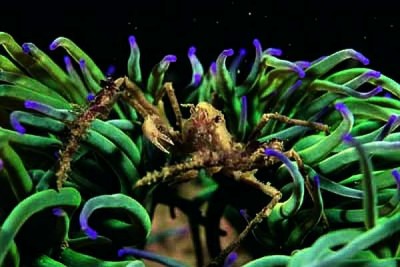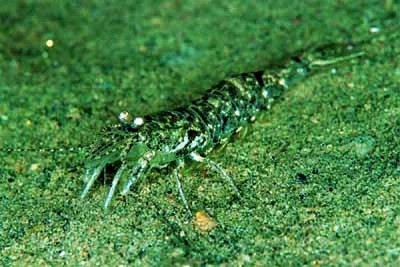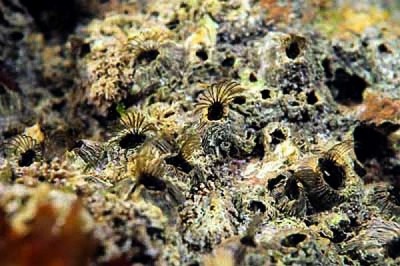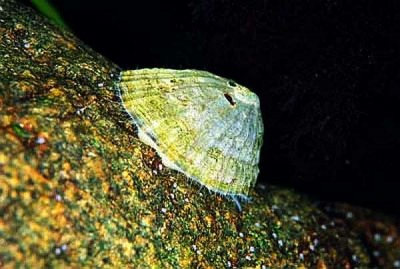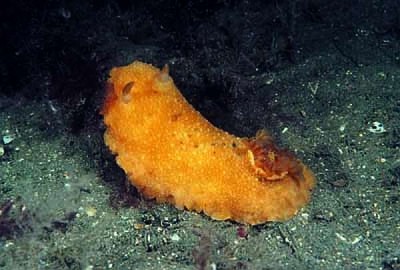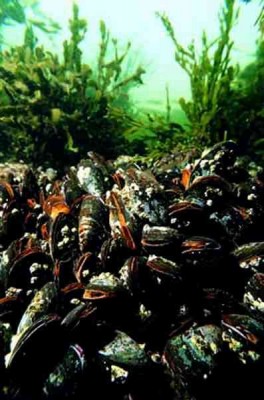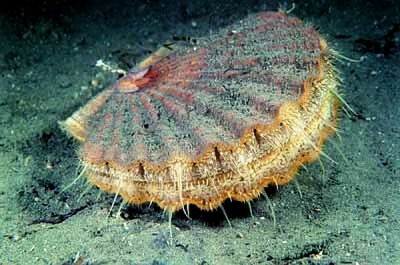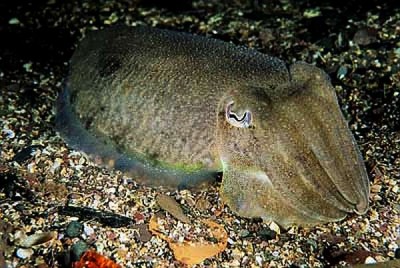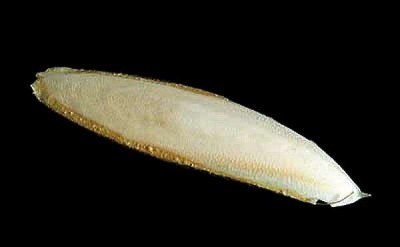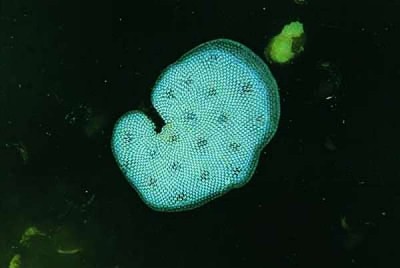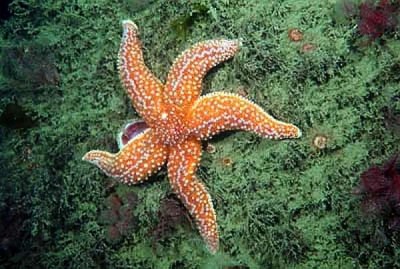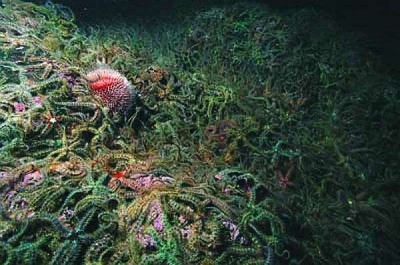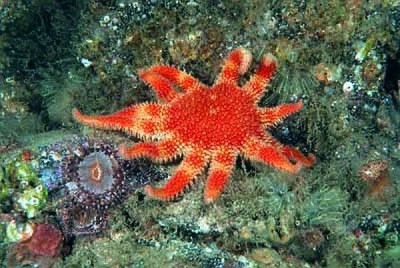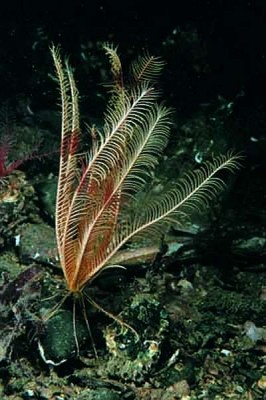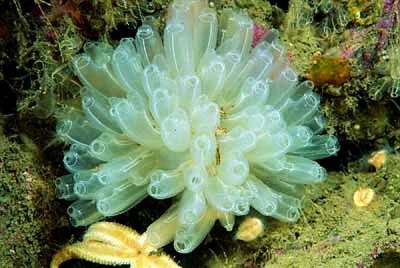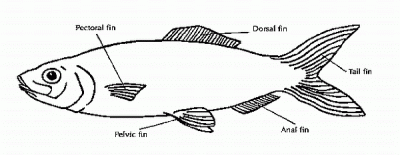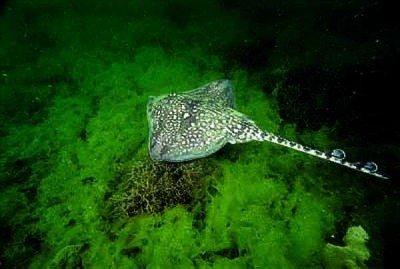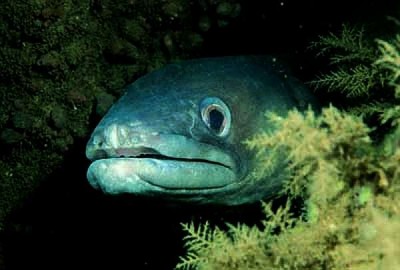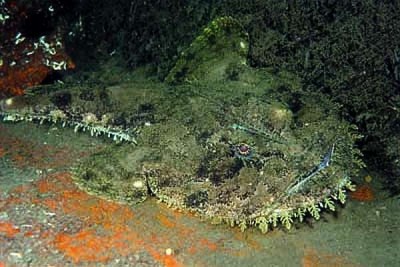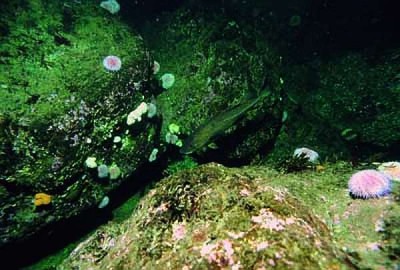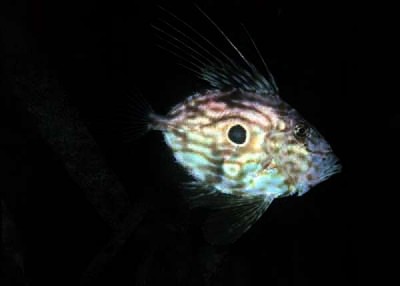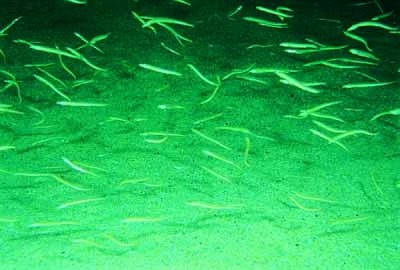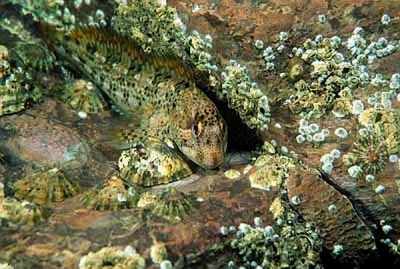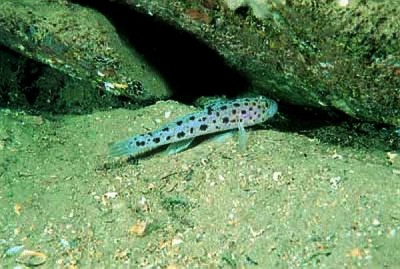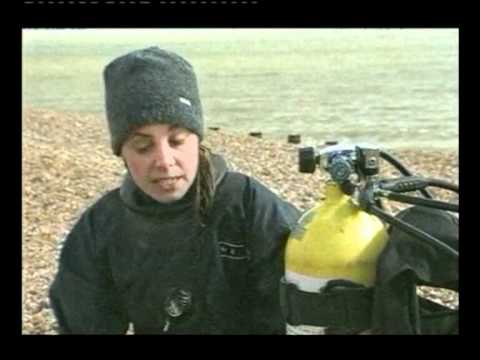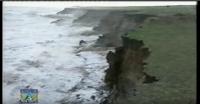An Illustrated Guide to UK Marine Animals
In order to illustrate this article, we have very kindly had these photographs made available to us by the marine photographer, Paul Naylor.
You can see more of Paul Naylor’s work on his website at www.marinephoto.co.uk and in his book Great British Marine Animals, 2005, 2nd edition, available from bookshops and dive shops, also from NHBS Environment Bookstore (01803-865913 www.nhbs.com).
All photographs illustrated here are the copyright of Paul Naylor.
Click them to display a larger image. You can return to the main text by clicking your ‘back’ button.
SPONGES
CNIDARIANS Sea Anemones — Corals — Hydroidshydroids Hydroids, or sea-firs, are plant-like animals. They resemble fir-like plants, but are actually the simplest of stinging-celled animals. The cells of these animals contain capsules (called cnidae), and these capsules contain a long hollow, coiled thread which uncoils and shoots out under water pressure when the cell is triggered by touch or water pressure. These threads, whose precise characteristics vary according to species, capture the prey. — Jellyfish
WORMS
CRUSTACEANS Crabs — Lobsters — Shrimps — Barnacles
MOLLUSCS Limpets — Sea Slug — Mussel — Scallop — Cuttlefish
BRYOZOANS Sea-mat — Bryozoan Bugula plumosa
ECHINODERMS Starfish — Brittle Stars — Sunstars — Sea Urchin — Sea Cucumber — Feather Stars
SEA SQUIRTS
FISH Fish Fins — Lesser Spotted Dogfish — Thornback Ray — Conger Eel — Angler Fish — Cod — John Dory — Lesser Sand Eel — Shanny — Leopard-Spotted Goby — Flatfish
SPONGES
Apart from single celled creatures, like amoeba, sponges are the simplest members of the animal kingdom. Their cells have different functions (for example: feeding, reproduction) but the cells do not form a complex structure as do the cells in higher animals. Sponges are essentially animated filters which draw water into a central cavity through pores (the tiny numerous holes all over its body) where special cells circulate the water within the body and collect the food particles that have been sucked in. Afterwards the water is expelled through larger outlet vents, or holes, on the surface of the sponge.
Sponges are supported by a rudimentary skeleton of spicules (needle-like structures made of calcium or silicon), protein fibres or both. When tropical sponges are dead and all other constituents of the body have been stripped away, it is the fibrous skeleton which remains that produces the traditional bath sponge. Most sponges are hermaphrodite (simultaneously male and female) but eggs and sperm from the same sponge mature at different times so a sponge does not fertilise itself. Sperm leave on the outgoing water, drift off to fertilise eggs in other sponges and free-swimming larvae are then produced. These larvae settle and, if the habitat is right, grow into new sponges.
In British waters the sea orange, also known as the sulphur sponge, is the classic example of a sponge. It forms a fairly large rounded mass with an even, but slightly rough, surface in which there are a vast number of tiny pores through which water is drawn in. In order to expel the water, every sponge also has at least one large circular opening (see photograph) through which the water is pumped out again. The sea orange is most common on rocks or stones where there is some mud present, and can also be found growing on the shells inhabited by hermit crabs. A typical sea orange may measure 20 cm across.
CNIDARIANScnidarians A class of marine animals which include sea anemones, corals, hydroids, sea pens and sea firs, and jellyfish. Cnidarians are distinguished by the fact that they possess stinging cells which are used both for defence and the capture of prey. These stinging cells contain a long, hollow, coiled thread which shoots out and uncoils under water pressure. Discharge is triggered by touch or chemical stimulus. The threads have different functions. Some simply entangle their prey, whilst others stick to it or inject poison. Most cnidarians have a two-stage life cycle. In one of these the animal takes the form of a polyp where it has a tubular body fastened to hard surfaces whilst during the alternate, known as the medusa stage, the animal is free-floating and swims in the sea. Sea anemones, for example, are usually encountered in their polyp stage; whereas jellyfish are usually encountered in their medusa stage.
Introduction
Sea anemones, corals, hydroids and jellyfish belong to a group of marine animals known as Cnidarians. All cnidarians possess stinging cells which contain discharge capsules, known as cnidae, and these capsules are used for both defence and the capture of prey. Each capsule contains a long hollow, coiled thread which, upon discharge, uncoils and shoots out under water pressure. Discharge is triggered by touch or chemical stimulus.
Different threads have different functions and, when thousands are triggered together, they can have a powerful effect. Some simply entangle their prey, whilst others stick to it or inject poison. Some even have blades which, when the thread twists, can act as tiny drills on the shells of small crustaceans.
Cnidarians are a step up the evolutionary tree from sponges but, apart from their exceptional weapon system, they are fairly simple animals and do not have proper organs like higher invertebrates. They have no true circulatory system, only a very simple nerve network, and when their tentacles (which are covered with a dense battery of stinging cells) capture prey these tentacles pass the prey to a central mouth. They have no anus, so the mouth is also used for the expulsion of undigested material.
Sea anemones
Cnidarians can occur either as a polyp (meaning, a tubular body with a wreath of tentacles around the mouth) which live anchored to the seabed, or as a free-swimming medusa (such as, jellyfish).
Sea anemones occur only in polyp form. These flower-like animals are found attached to rocks and other hard surfaces. Water pressure inside the body maintains the anemone’s shape and the basis of its muscle action. They reproduce by producing eggs which normally develop into adults via a planktonicplanktonic Free-floating, drifting (free-floating) larval stage, but sometimes reproduction may occur asexually when an adult splits or buds to form a new individual. In such circumstances, dense colonies can result.
The snakelocks anemone lives on rocky reefs in shallow British waters, rather than on the darker world of underwater cliffs and overhangs where most species of anemone are found. Its two hundred or so long wavy tentacles are very sticky, and are often rich green in colour with purple tips. The sun-seeking habit of snakelocks is related to the fact that the tissues of its tentacles contain large populations of a special symbiotic algae, and the algae probably account for the green colouration of the tentacles. The algae gain protection along with a supply of carbon dioxide and salts from the anemone, whilst the anemone benefits from organic compounds synthesised by the algae using sunlight as its energy source. The algae may also help to remove the anemone’s waste products. Snakelock anemones also have some kind of relationship with Leach’s spider crab and the two animals are often found living together [see section on Crustaceans below]. Snakelocks can measure, with tentacles, up to 20 cm across and are found in western rather than eastern British waters.
The plumose anemone occurs in large numbers in British waters, covering expanses of seabed or wrecks. In its fully active state, this anemone has a tall smooth column topped with a crown of very numerous fine, slender tentacles which give the animal its characteristic feathery appearance. When contracted, the anemone appears as a little mound. Individuals may be white, orange, green or brown in colour, and this species has a strong preference for areas of strong water flow, hence its frequent position on rock pinnacles or prominent pieces of wreckage. It can also be found in shallow, shady spots such as overhangs and jetty pilings, and individuals grow up to 30cm tall.
Corals
Corals are cnidarians, and essentially the same type of animal as sea anemones. Like sea anemones they occur in the polyp form, but differ in that they produce some kind of skeleton to support and protect their bodies. Stony corals, which are usually colonial, have fused chalky skeletons and are able to form huge coral reefs in tropical waters. Soft corals, sea fans and sea pens are also colonial, but their “mutual skeleton” is not a solid mass of calcium carbonate (as with stony corals) but rather is gelatinous with embedded calcareous spicules which give the skeleton strength and some rigidity. Not all corals are colonial, and some of the commonest British species are solitary.
Dead men’s fingers is a British species of soft coral. It is colonial and can cover large areas of underwater rocky cliffs or seabed. This coral is generally white or orange in colour, and each “finger” is a colony of tiny animals which has formed a mutual skeleton of gelatinous material (hence soft coral) strengthened by calcareous spicules (needle-like structures). Until an individual colony — single “finger” — has reached a height of 5cm it remains unbranched, but once the colony has grown larger it tends to divide into several lobes and if arranged in a single plane, as they often are, a group of lobes or “fingers” then appear like a hand — hence it’s name. When active and feeding, the colonies extend their translucent tentacles and the lobes have a “furry” appearance. However, in autumn, most colonies stop feeding for several months whilst they prepare to spawn and the tentacles are no longer in evidence. As these animals rely on capturing suspended food, they are commonest in areas of moving water and can grow up to 20cm tall.
Hydroids
Hydroids, or sea firs, resemble plants but are in fact the simplest of the stinging celled animals — cnidarians. Most hydroidhydroids Hydroids, or sea-firs, are plant-like animals. They resemble fir-like plants, but are actually the simplest of stinging-celled animals. The cells of these animals contain capsules (called cnidae), and these capsules contain a long hollow, coiled thread which uncoils and shoots out under water pressure when the cell is triggered by touch or water pressure. These threads, whose precise characteristics vary according to species, capture the prey. species occur in both the polyp (tubular body, usually attached to a hard surface) and medusa (free-swimming) form at different stages of their life cycles, but the polyp form is dominant. The polyps form colonies where they are linked by strands of living tissue, and individuals may serve different functions (e.g. feeding, reproduction) within the colony.
The hydroid illustrated here, the Oaten pipe hydroid, is often found in British waters in large colonies on rock faces exposed to strong currents. Numerous long, thin and straw-like stems rise up from a mat of tangled fibres and these stems support polyps that have pink bodies with a crown of long white, droopy-like tentacles. The reproductive parts appear like a bunch of grapes near the centre of the crown, and this species produces a creeping larva rather than a free-swimming medusa. Individuals grow up to 15cm tall.
Sea pens look like plants but they belong to the family of Cnidarians (stinging celled animals). The phosphorescent sea pen has a thick stem and large side leaves, and its bright white polyps contrast with its deep red “body”. As its name suggests, it produces brilliant flashes of light when its body is touched at night. It can be found in most British waters and grows up to 30 cm tall.
Jellyfish
Jellyfish are cnidarians. Amongst cnidariancnidarians A class of marine animals which include sea anemones, corals, hydroids, sea pens and sea firs, and jellyfish. Cnidarians are distinguished by the fact that they possess stinging cells which are used both for defence and the capture of prey. These stinging cells contain a long, hollow, coiled thread which shoots out and uncoils under water pressure. Discharge is triggered by touch or chemical stimulus. The threads have different functions. Some simply entangle their prey, whilst others stick to it or inject poison. Most cnidarians have a two-stage life cycle. In one of these the animal takes the form of a polyp where it has a tubular body fastened to hard surfaces whilst during the alternate, known as the medusa stage, the animal is free-floating and swims in the sea. Sea anemones, for example, are usually encountered in their polyp stage; whereas jellyfish are usually encountered in their medusa stage. species, they most closely resemble hydroids in that they have both polyp and medusa stages (polyp: tubular body usually attached to hard surfaces, medusa: free-floating), but with jellyfish it is the medusa stage that dominates and thus it is usually encountered as a large floating predator. The body of the jellyfish typically forms a bell or umbrella shape which is able to contract rhythmically to propel itself through the water. As is the case with all cnidarians, it has tentacles armed with stinging cells which catch prey and then pass the prey to the mouth. In this sense they are “floating” sea anemones. When free-floating in the sea (medusa stage) male jellyfish release sperm into the seawater which are drawn in through the female jellyfish’s mouth to fertilise eggs. These eggs develop within the female, and are then released as free-swimming larvae. The larvae settle on the seabed and develop into small polyps with long tentacles. The polyp grows and, as it grows, its body splits across the horizontal plane to form a stack of saucer-shaped structures, each sitting on top of the other. When the polyp matures, these “saucers” separate off and are released as free-floating miniature jellyfish which grow into adults. Nearly all jelly fish follow this polyp-medusa life cycle (with one or two exceptions which skip the polyp stage), and the polyp stage usually goes unnoticed.
The compass jellyfish lives in British waters, and it is identified by a radial pattern of dark brown V-shaped markings on its “umbrella” or “bell”, along with an additional dark pattern around the rim of the umbrella. Twenty-four slender (marginal) tentacles hang down from the edge of the umbrella, whilst four more noticeable (oral) arms are located in the centre. The marginal tentacles extend when the animal is hungry in order to catch prey, and when prey is caught (any planktonic animal) the marginal tentacles contract to pass the captured prey to the oral arms and from thence to the mouth. When feeding is finished, the marginal tentacles remain contracted. The jellyfish orientates itself by means of eight sense organs, one of these sense organs being located between each group of three marginal tentacles. Young fish, particularly whiting, can often be found swimming around the compass jellyfish’s tentacles. It is thought that this affords the young fish with protection from predation by larger fish who avoid the tentacles. The sting from a jellyfish can sometimes cause a painful reaction on exposed human skin. The umbrella of a compass jellyfish can grow up to 30cm across.
WORMS
Introduction
Few animals would appear to be less interesting than worms, and the name tends to be applied to any animal that is long and wriggly. However worms are actually quite complex creatures and, in some cases, unexpectedly interesting. There are essentially three groups of marine worms in British waters — flatworms, ribbon worms and segmented worms.
Flatworms are primitive leaf-shaped animals, but are regarded as more advanced than cnidarians (sea anemones, jellyfish) because of the way their bodies are organised. In cnidarians, cells are grouped to form tissues but that is as far as the organisation goes and cnidarians do not possess organs in the normal sense. In flatworms however the tissues work together to form organs with a specific function, such as digestion, and thus flatworms are regarded as an ancestral group from which other more advanced animals are descended. However the organs of flatworms remain fairly crude and their digestive system, for example, has a single opening which must serve as both mouth and anus.
Ribbon worms are thin and long and, although quite primitive, are slightly more advanced than flatworms. They have, for example, an anus as well as a mouth and thus a more efficient digestive system. Ribbon worms also have a circulatory system, possess more advanced muscles and nerve networks, and have a proboscis (a trunk-like extension near the mouth) which is used both for trapping prey and in defence. An example of a ribbon worm is the Bootlace worm — Lineus longissimus — which as its name implies is long and thin in length, usually around 5 metres when extended, but some individuals can grow to over 30 metres.
Segmented worms are more developed than flatworms and ribbon worms and, in terms of complexity, are on a par with most crustaceans and molluscs. Segmented worms have a proper inner body cavity which permits the development of sophisticated internal organs, and they have a nervous system of sufficient complexity to support a variety of behaviour patterns. Most marine segmented worms belong to the sub-group known as bristle worms and, typically, they have heads with intricate jaws, antennae and sense organs, whilst the rest of the body consists of less specialised segments all fairly similar to one another. Many segmented worms move freely from place to place but, because they burrow into the soft seabed or remain hidden amongst organic debris on rocky seabeds, they are rarely visible. Those which are most visible are the species which live in a tube which they have constructed. In such species of tube worm the head, or crown, can often be seen protruding from the opening of the tube, and this head will often take the form of feathery tentacles deployed both to capture food and for respiration. In some species, such as the Fan worm — Bispira volutacornis — or the Peacock worm — Sabella pavonina — displays of these tentacles can be very striking.
Lugworm — Arenicola marina
The lugworm is a segmented worm. Although it does not build its own tube (like segmented tube worms), it lives in a long U-shaped burrow which is lined with mucus to prevent its collapse. Lugworms feed on organic material in muddy sand, are rarely seen, and have to swallow enormous amounts of sediment in order to obtain adequate nutrition. As a result, their presence is most noticeable via their coiled casts which represent processed material ejected by the worm while the small hollow in the sand nearby is where water, for respiration, and fresh sediment is drawn down into the burrow. The worms grow up to 25 cm long, and their casts can measure 20 cm across.
CRUSTACEANS
Introduction
Crustaceans have been likened to aquatic animals which wear “suits of armour” — hard shells. This armour or shell is jointed, and crustaceans belong to a larger group of animals known as Arthropoda — which means “jointed legs”. Insects have jointed legs and are Arthropoda and, in many ways, crustaceans are aquatic insects.
Crabs, lobsters, crawfish, prawns and shrimps all have a similar body structure and all belong to the same sub-group of crustaceans known as the Decapoda — which means “ten legs”. The first (front) pair of these legs are often claws and with some crustaceans, such as the lobster, one claw acts as a “crusher” of prey (usually the right claw) whilst the other serves as a “cutter” (usually the left claw). The head and thorax (body) of all Decapoda are fused and are covered by a single section of armour (shell), known as the carapace. The abdomen and tail is protected by further sections of armour. In the case of lobsters and shrimps the tail is obvious, whilst in crabs the tail is often tucked up as a flap underneath the rest of the body.
Barnacles are also a member of the crustacean family, but belong to a separate sub-group.
The shells or suits of armour worn by crustaceans have obvious benefits. They provide good protection against predators, rigid anchorage points within the body for powerful body muscles, and hard surfaced limbs for crushing, cutting and grinding their prey. However the main drawback of these suits of armour is that they have to be shed periodically to allow for growth of the body, and until the newly exposed leathery skin hardens into a new shell the animal is very vulnerable.
A crustacean will occupy several shells during its lifetime, each new shell being larger than the last. When a shell becomes too small for the growing body it has to be discarded — known as a moult — and the shell splits at a pre-determined point to allow the animal to climb out, clad only in its soft coat. During this exercise of vacating an old shell the animal has to take care to ease out all the limbs and body parts, including the eyes and tiny mouthparts.
Once the old shell has been left behind, the soft crustacean swells itself up with water so that its body is temporarily larger, thus ensuring that as its soft leathery skin forms into a new suit of armour (shell) the suit is a size larger than required. This affords space for the body to grow before the shell has to be discarded again. It takes several days for the shell case to harden, and during this period the animal is very vulnerable and has to stay hidden and feeding is consequently very restricted. Once the case is hard, the crustacean emerges from its hiding place and seeks food voraciously.
The shedding of the shell — moulting — is also central to reproduction because the female of most crustaceans is only receptive just after she has shed her shell. As a result male and female crustaceans, particularly crabs, will frequently pair off to await the female’s moult.
The life-cycle of virtually all crustaceans involves a planktonic (free-floating) larval stage once the mature eggs are released by the female. The larval stage also involves moults, usually at least three, and after each moult the crustacean begins to look more like the adult version of its species. In the case of crabs, a miniature adult will leave the planktonic stage and settle down on the seabed after approximately three larval moults, and then go through approximately twelve moults before arriving at a large, mature adult capable of breeding.
Although the moult creates dangerous interludes in the life of the crustacean, it also affords an opportunity for the animal to regenerate a lost limb which may have been accidentally damaged or seized by a predator. When a limb is lost it breaks off at a point deliberately close to its base with the body, and a new limb can then start to form within the shell. At the next moult this new limb will then emerge, and the new case will harden to protect it, with the new limb enlarging at each subsequent moult until it has regained its appropriate size.
In the case of lobsters and crabs which have two large front legs (claws) — one for crushing, the other for cutting — should the crushing claw be lost due to some misfortune then the cutting claw can convert to a crusher, whilst the old crushing limb regrows as a new cutting limb, enlarging in size during successive moults.
Velvet swimming crab
The velvet swimming crab is abundant in British waters. It gains its name from the fact that its body (carapace) is covered with short greyish-brown hairs which give it a velvet-like appearance and because, in common with other swimming crabs, the final section of its rear-most pair of legs is flattened to form an effective swimming paddle. In addition to these distinctive features, the velvet swimming crab can also be recognised by its bright red eyes and the blue lines on its legs and claws.
Velvet swimming crabs are pugnacious creatures and, when encountered, they can rear up and spread their claws in defiance rather than retreat into some crevice. These crabs can be found both on rocky, stony sea beds and also sandy, muddy sea beds where they will often dig themselves in. Being fast-moving and agile creatures, they can catch fish and prawns for food as well as feeding on bottom-living creatures such as molluscs and worms. Openly and actively carnivorous, velvet swimming crabs are also known to eat large quantities of seaweed.
In common with all crabs, the velvet swimming crab mates shortly after the adult female has moulted, and the male will accompany the female and physically hold onto her for some while until the moult arrives. In this pre-mating embrace the male crab will “sit” on top of the female and effectively carry her around, but when the female eventually moults and copulation occurs the female is “upside down” and will lie underside-to-underside with the male. Following fertilisation, the female will carry her eggs as a large mass (noticeably granular in texture and orange in colour) on the underside of her body prior to releasing them as larvae. Whilst carrying her fertilised eggs the female is said to be “in berry”. The carapace of the adult velvet swimming crab will typically measure 10 cm across.
Leach’s spider crab
This spider crab has a triangular carapace, with very long and slender legs. However its front claws, which are usually folded under its body, are relatively sturdy. The crab often seems virtually invisible because its carapace, claws and legs are frequently covered with sponge and bits of algae, and it has a particular habit of either hiding around the base of a snakelocks anemone or sitting within the anemone’s tentacles (see photograph).
In some areas, virtually every snakelocks anemone has its resident Leach’s spider crab. However the relationship between the anemone and this crab is somewhat of a mystery. The adult Leach’s spider crab typically has a carapace which measures up to 3 cm across.
Common lobster
The common lobster is largely nocturnal, making sightings uncommon. However when it does appear from its lair during the day it is a magnificent sight — it has dark blue armour with pale yellow markings and long, bright red antennae. Its front claws are powerful, and each is of a different shape. One is heavier and used for crushing (usually the right-hand one) whilst the other is sharper and serves as a cutting tool. Lobsters generally move about by walking, but they can also swim backwards rapidly in short bursts by using their powerful tail as a paddle.
Lobsters normally live in deepish water, but can be found in shallow water if there is sufficient shelter. They feed on a variety of bottom-living animals, alive or dead, and are also well known as cannibals — which means they are difficult to keep in an aquarium because as soon as one lobster moults it will likely be eaten by its companion.
Mating is thought to occur in late summer, but females can store the sperm packet over winter and not fertilise its eggs until the next summer. Fertilised eggs may take a year before they emerge as free-swimming larvae and these larvae will go through several moults before transforming into miniature lobsters and settle down on the seabed. As juveniles, lobsters moult regularly but once they become a large mature adult they moult only occasionally. They live for up to 50 years and although their body can be up to 75 cm long, a normal size rarely exceeds 30 cm.
Brown Shrimp
The brown or common shrimp is abundant in sandy areas. However its mottled sandy colour provide it with good camouflage and, allied to its tendency to remain buried in sand with only its eyes visible, it is difficult to spot and observe.
Compared to a prawn, the head and body of a brown shrimp is more flattened and is almost flush with the seabed, and the brown shrimp’s front pair of claws are more substantial than those of many prawns. The shrimp has a varied diet which includes small worms and crustaceans as well as algae and detritus. A brown shrimp grows up to 9cm long.
Barnacle
Until 1830 barnacles were considered to be molluscs because of their sedentary life-style and limpet-like shape, but when their larvae were studied it was found that these are like other crustaceans and their true identity was revealed.
A barnacle has been described as being “like a shrimp which glues its head to a rock, lives in a house and kicks food into its mouth.” This is, in fact, entirely accurate. Glands on the barnacle’s head produce a special cement for permanent attachment, the usual crustacean armour is modified to form flat plates which make up the “house” or shell, and the limbs are extended out from the shell to form a sieve for catching planktonplankton Plankton is a generic term for a wide variety of the smallest yet most important organisms form that drift in our oceans. They can exist in larger forms of more than 20cm as the larval forms of jellyfish, squid, starfish, sea urchins, etc. and can be algae, bacterial or even viral down to as small as 0.2µm. They are nutrient and light dependent, and form the essential foodchain baseline for larger dependent aquatic lifeforms. Fish species rely on the density and distribution of zooplankton to coincide with first-feeding larvae for good survival of their larvae, which can otherwise starve. Man-made impacts such as dredging, dams on rivers, waste dumping, etc can severely affect zooplankton density and distribution, which can in turn strongly affect larval survival and thus breeding success and stock strength of fish species and the entire ecosystem. They also form the essential basis of CO2 take up in our seas ecosystem, hence Global Warming.. In the photograph, these limbs can be seen protruding from the shell and they rhythmically sweep the water above them like a grasping hand.
Barnacles occur in large populations on the shore or in shallow water. They are hermaphrodites (simultaneously male and female) and mating usually occurs between neighbours. The resulting embryos develop within the parent until being released to become free-swimming planktonic larvae which develop further still before taking on the adult form. At this point they then glue themselves head-first to a rock and quickly assume the common adult form (see photograph), measuring up to 3 cm across.
MOLLUSCS
Introduction
The typical mollusc has a hard, chalky external shell, and the term Mollusc is derived from the Latin word which refers to the soft body which is generally enclosed in the hard shell. Some molluscs have a shell which has only one part, such as limpets and whelks. Other molluscs have a shell made of two parts, such as mussels and scallops. And some molluscs actually have no shell at all, such as nudibranch sea slugs and octopuses. The number of species of marine animals which are molluscs is very large and include — in addition to those already mentioned — sea snails, periwinkles, oysters, cowries, cuttlefish and squid.
The body of a typical mollusc is made up of three parts. These are, firstly, a strong muscular foot which forms the base of the animal and, in the case of many species, represents the animal’s principal contact with the outside world. The second main part of its body is the visceral mass (the part of the body which contains the organs) and this includes the digestive and reproductive organs. And the third part is the mantle tissue which secretes the proteins and chalky crystals that combine to make the mollusc’s shell. Interestingly, the head of the mollusc — with the sensory organs of eyes and tentacles — is located on the front end of the foot.
With the exception of bivalves (mussels, scallops), most molluscs use an intricate feeding mechanism — known as the radula — which is unique in the animal kingdom. The radula is a ribbon of horny tissue, bearing teeth, which is drawn backwards and forwards across the food like a file. In addition to acting like a rasping file, the radula also acts like a conveyor belt and, as the food is obtained, it conveys the food to the digestive tract. The precise form of the radula varies between molluscs, depending on whether the mollusc is mainly vegetarian or carnivorous, however in all cases this radular feeding mechanism is continually replaced, with new teeth being produced at one end and worn teeth broken off at the other end. By contrast, bivalves (mussels, scallops) are filter feeders. They possess large gills — far larger that that needed for respiration alone — and inside these gills are tiny hairs, known as cilia. The cilia beat in unison to create a powerful water current through the bivalve’s body cavity, and a further set of cilia (tiny hairs) trap food and move it towards the digestive tract.
It is this filtering ability of bivalves which make them such important animals in the maintenance of good water quality in river estuaries and, at the same time, potentially dangerous purveyors of food poisoning if harvested from polluted coastal areas. Consequently, the harvesting of cockles, oysters and other bivalves is carefully regulated.
Whereas the bivalve has a shell composed of two halves — and the name bivalve means “two shells” — it is actually one shell which has a strip down the middle which is less calcified than the remainder, thus enabling the shell to fold in on itself as if on a hinge. In the case of the archetypal mollusc — limpets, whelks, top-shells, tower shells and periwinkles — the shell is clearly singular and, in many cases, coiled. Also, unlike the crustaceans and their all-encompassing body armour, the mollusc shell can be gradually enlarged as the animal grows, and therefore does not have to be periodically shed. A mollusc will therefore live in the same shell during its whole life.
In contrast sea slugs, which are also molluscs, either have a reduced shell or, in many species, no shell at all. Those species which have no shell — called nudibranch sea slugs, the term meaning “naked gill” — have, consequently, to rely on other means in order to defend themselves. In some species the skin of the sea slug has glands which produce a toxin, whereas other species have an even more impressive system whereby they feed on animals with stinging cells (sea anemones, hydroids) and then preserve and utilise these second-hand stinging cells for their own defence.
A further, fascinating sub-group of the molluscs are the cephalopods — cuttlefish, squid and octopus. In these animals the typical mollusc foot has become a set of tentacles attached to the head (cephalopod means “head-foot”) and the mantle tissue (which would normally secrete material to make the shell) has formed a jet propulsion organ to enable the animal to move with speed. The cuttlefish still retains an “internal shell” — known as the cuttlebone — which provides the animal with a sort of internal skeleton, but in the case of octopus and squid even the internal shell has been dispensed with and the animals simply have a soft, bag-like body.
More remarkable still, cephalopods (cuttlefish, squid, octopus) display intelligent behaviour. In the typical mollusc there are several nerve centres scattered around the body, but in the case of cephalopods these nerve centres are fused together and enlarged to form a brain which is enormous by the standards of invertebrates [invertebrates are animals without a backbone and all the animals in this article, except the fish, are invertebrates]. As a result cephalopods display the ability to learn, and they can remember what they have learnt and observed for several weeks.
Reproductive strategies vary enormously between different species of mollusc. Some simply shed eggs and sperm into the water, whilst others employ internal fertilisation and then attach their eggs to the seabed, vegetation or even other animals. Still further, other species brood eggs within their bodies, and then produce youngsters which resemble miniature adults complete with a shell.
Common Limpet
Limpets are abundant, have a distinctive conical shell and can be found on virtually all rocky shores. It is this robust conical shell that is usually seen, very firmly fixed to a rock. In fact the limpet creates a “home base” for itself on the rock by grinding an exact space on the rock’s surface, and then leaves and returns to this exact spot after foraging for food during periods when the rock is submerged by the tide. Indeed this exact fit into a precise space on the rock is a survival mechanism, providing the limpet with a tight seal which prevents the animal from drying up when the tide is out.
When a limpet is actually encountered crawling along (see photograph) the muscular foot and a pair of large head tentacles can be seen, along with numerous tiny tentacles around the edge of the shell. When the tide is in and they are covered with water, limpets crawl around to graze on algae, and they leave behind a trail of mucus which they use to navigate their way back to their “home base”. It is also thought that limpets have some sort of memory.
Large limpets are also capable of defending themselves against predatory starfish. When under attack, they appear to lift up their shell and then slam the edge down on the starfish’s arm. A limpet’s shell will grow up to 6cm in length.
Sea Lemon Sea Slug
Sea slugs form a numerous sub-group of the mollusc family, and there are many different species.
Many of these species do not actually possess a shell which is of course the characteristic trait of many other molluscs, and these shell-less species of sea slug are known as nudibranch sea slugs which means “naked gill”. In order to protect themselves, most nudibranch sea slugs secrete poisons from their skin — although some species eat cnidarians (stinging-celled marine animals such as sea anemones and hydroids) and these species retain the stinging cells of their prey and put them to their own use by incorporating them into the tips of cerata (spike-like extensions on their body).
The sea slug featured here (see photograph) is the Sea Lemon and is very common in British waters. It is one of those species which secretes poisons from its skin glands in order to defend itself. The upper side of its body is covered in small wart-like bumps, and the skin usually bears blotchy markings which can be any combination of yellow, pink, white, brown or green. The Sea Lemon feeds exclusively on sponges, particularly the breadcrumb sponge — Halichondria panicea — and the Sea Lemon’s garish colours often make this animal very difficult to see on these sponges.
Sea Lemon sea slugs normally live for about a year. The adult male and female mate and spawn in the spring before dying, and the juveniles hatch from their eggs in late summer and grow through the autumn and winter. Adults grow up to 12 cm in length.
Common Mussel
The common mussel is a bivalve mollusc. There are two essential features of bivalve molluscs. Firstly, they have a single shell made of two halves where the two halves can close together tightly and securely to seal the animal inside when needed, and secondly, the ability to feed by filtering food from the surrounding water which is pumped (siphoned) through the body in large quantities.
The common mussel often occurs in large colonies on the shore or in shallow water, and its shell is blue, black and brown in colour. Mussels anchor themselves to rocks and each other by means of sticky threads, called byssus. The mussel has an extendable foot which can reach some distance out of the shell, and this foot plants the threads so as to anchor the shell rather like the guy ropes do for a tent.
As mentioned, mussels feed by filtering food from the surrounding water which they pump through their body, and the water enters via the frilly-edged opening (see photograph) and leaves via the smooth-edged tubular opening.
On account of their habit of living in colonies and their ability to secure themselves to one another and the seabed, mussel colonies provide a secure habitat for other species of marine animal who would otherwise be swept away by strong currents or be easily eaten by predators. This feature is particularly true of the Horse mussel — Modiolus modiolusModiolus modiolus The horse mussel Modiolus modiolus forms dense beds at depths of 5-70m in fully saline, often moderately tide-swept areas off northern and western parts of the British Isles. Although it is a widespread and common species, true beds forming a distinctive biotope are much more limited and are not known south of the Humber and Severn estuaries. Off North Sea coasts occasional beds occur between Berwickshire and the Humber, and probably elsewhere. M. modiolus is a long-lived species and individuals within beds are frequently 25 years old or more. Juvenile M. modiolus are heavily preyed upon, especially by crabs and starfish, until they are about 3-6 years old, but predation is low thereafter. There have been no studies of the recovery of damaged beds but full recovery after severe damage would undoubtedly take many years at best and may not occur at all. — whose colonies in deeper water (known as “biogenic reefs” ) provide a secure habitat for an extremely rich biological community which includes worms, crabs and brittlestars which live in the crevices between the shells, as well as hydroids, bryzoans and sea squirts which attach themselves to the surface of the shells. In the case of colonies of the Common mussel — Mytilus edulis — (see photograph) these provide habitat for other marine species such as gobies, barnacles, crabs, periwinkles and dog whelks.
Despite their tough shells, mussels have a large number of predators. The common mussel may be pulled open by starfish, broken open by crabs or drilled into by dog whelks. They can even be attacked from inside by tiny pea crabs who ride in on the water (feeding current) and then take up residence, using the mussel as a permanent larder. The common mussel can grow up to 10 cm in length, but it is usually smaller.
Great (or King) Scallop
The Great scallop is a bivalve mollusc. However it differs from many bivalve molluscs in that the two halves of its shell are not identical in shape. Rather, the lower half is curved like a bowl whilst the top half is flat, like a lid. Where both halves are identical is in possessing distinctive radiating furrows or ribs.
Like other bivalve molluscs, the scallop is a filter feeder. In the photograph the two halves of the shell are open as the animal feeds and, along the edge of the open shell, the numerous small tentacles can be seen and, in the furrows, several tiny metallic-blue eyes are also evident. Behind the tentacles the soft body of the animal with its attractive patterning can also be glimpsed.
Scallops use a rocking motion to make a hollow in the sand or gravel where they sit whilst feeding and, if they wish to move or to escape a predator, they are capable of swimming short distances by, almost comically, snapping their shells as their soft body tissue creates jets of water with which to propel and control their movement. The shell of a Great scallop can measure up to 15 cm across.
Common Cuttlefish
The cuttlefish is one of the most remarkable animals to be encountered in British waters. It belongs to the mollusc family, but in common with the octopus and squid, it does not have the outward appearance of a mollusc and belongs to a sub-group known as the cephalopods, meaning “head-foot”.
In common with all molluscs, its head is attached to its foot, and its mouth is surrounded by eight “arms” or tentacles. It also has two much longer, extendable tentacles although these are not normally visible. The cuttlefish also has a fin on each side of its body which runs from behind its head all the way back to its rear.
The cuttlefish has the ability to produce a powerful jet of water which enables it to move rapidly backwards should it need to escape danger and, when doing so, it will also release a cloud of black ink which will hang in the water and thus distract its pursuer. If still pursued, it will emit further clouds of black ink. This ink, called sepia, was once used by artists. Under less extreme conditions, the cuttlefish moves slowly by means of this same jet propulsion technique aided by a gentle rippling of its side fins for stability.
The cuttlefish is a master of camouflage and, in the opinion of some, exceeds the abilities of the chameleon. When a cuttlefish swims over a varying coloured seabed, its shade can change instantly to match its surroundings, going from dark over kelp covered rocks to almost white over sand. Moreover, the animal appears to calculate all angles, appearing to match the colour of the seabed against which it is being observed and not just directly below it. This ability to change its colour is evident in the photographs. In the first photo the cuttlefish has come to rest on a gravel seabed and within a few seconds, second photo, it has matched that seabed perfectly. In addition, the cuttlefish’s skin will also change in texture to replicate that of its surroundings, and the animal will further supplement its camouflage by flicking sand and gravel over itself as it sinks into the seabed.
Cuttlefish are also able to change their body pattern, and thirteen different patterns have been observed, with these differing patterns being made up from at least thirty different components. For example, one pattern can consist of white squares with dark/light shaded ripples, whereas another consists of brilliant white zebra-like stripes. A cuttlefish can move through this repertoire of patterns almost in a flash, and the secret of this rapid pattern change has been attributed to special cells, known as chromatophores, which are effectively bags of pigment which are manipulated by muscular action.
The brilliant zebra striped pattern is often used during courting, and mating is achieved by the male passing a packet of sperm to the female by using one of his arms specially adapted for this purpose. When the female lays her eggs these are laid in clumps, dyed black with ink and are attached to vegetation. These clumps are easily visible and are known as “sea grapes”. The youngsters hatch after two to three months, are around finger-nail size, and immediately display all the patterning ability of their parents.
Females only breed once, and die soon after. After their body has decomposed their internal skeleton, or cuttlebone is left and this can often be found washed up on beaches. During life, the cuttlebone is the animal’s buoyancy organ. It consists of stacks of thin-walled chambers which can be filled with air or liquid to give the animal the right degree of lift. Cuttlefish live in relatively deep water during winter — although not too deep otherwise the cuttlebone will implode under the pressure — and move to shallower waters in the spring and summer to breed.
Cuttlefish are impressive predators, able to catch fast moving prey such as fish and prawns with their long tentacles and crabs, with their dangerous front claws, are cunningly outwitted by being approached from the rear. Apart from sea mammals, cuttlefish (along with octopus) are generally regarded as the most intelligent of marine animals, and many divers have reported the sensation that whilst observing cuttlefish they have equally been observed in return. Cuttlefish grow up to 30 cm long.
BRYOZOANS
Introduction
Bryozoa are a class of tiny marine animals which live in colonies that resemble plants and some species can easily be mistaken for seaweed, whilst other species look like mosses. The name bryozoa means “moss animal” and the whole class of animals — the phylumphylum A technical term used in the classification of plants and animals relative to one another. It means a primary division or "sub-kingdom" amongst those animals and plants which are considered to be related. (a technical term used in the classification of plants and animals relative to one another, and means a primary division or “sub-kingdom” amongst those animals and plants which are considered to be related) — are sometimes called “sea mosses”.
Bryozoans are stationary colonies of tiny animals, and the animals themselves are known as “zooids”. The body of most zooids is specialised for feeding, and each of these tiny animals has a ring of tentacles which surround its mouth. This is similar in pattern to a hydroid or sea anemone, but in the case of bryozoans there are no stinging cells in the tentacles (as there are in hydroid and sea anemone tentacles) and instead the bryozoan’s tentacles are equipped with numerous hairs, called cilia. The cilia beat rapidly and create currents which cause microscopic organisms, such as single-celled algae and bacteria, to be carried into the bryozoan’s mouth. All bryozoans possess a U-shaped digestive tract for digesting this food, and the undigested remains pass out of the anus which is situated near to but just outside the ring of tentacles.
In a bryozoan colony each individual zooid (animal) lives in its own case. Each case is less than 1 millimetre across, and is usually shaped like a box.The walls of this box are often reinforced with calcium compounds and a colony is, effectively, a network of all of these boxes joined together. This network of boxes often has a mesh-like appearance, and it is this particular appearance which is a distinctive characteristic of bryozoans. When feeding is underway, a network of tentacles can be seen protruding from these boxes, and the tentacles are instantly withdrawn upon the slightest disturbance.
In most bryozoan colonies it is not uncommon for certain zooids (the tiny animals) to have a specialised function beyond simply that of feeding. Some of the zooids attach the colony to the seabed, whilst other defend the colony against the larvae of other creatures or larger animals — such as worms — which may crawl over the colony and cause damage. There are also zooids which specialise in reproduction. Whilst all bryozoan colonies are hermaphroditic (male and female at the same time), some bryozoan species have zooids which are separately male and female, whilst other species have zooids which produce both eggs and sperm. Fertilised eggs are usually brooded within the colony, and the resulting larvae emerge to swim around for a few hours before choosing a suitable place in which to settle. The larvae then transform into zooids which, in their own turn, then bud (reproduce asexually) to produce more zooids and, as this budding process is repeated, a new colony is formed.
Sea-mat
The distinctive colonies of the sea-mat are encountered as a layer of fine lace-like mesh attached to the fronds of seaweed, particularly kelp. Although tiny, the individual rectangular “boxes” which make up the colony are clearly visible. These boxes, arranged in rows like brickwork, give the colony sufficient flexibility to cope with the bending of the kelp frond, whilst the location of the colony, usually near the base of the frond, ensures that the colony stands a reasonable chance of survival should the frond itself become damaged. The photograph shows a colony which measures just a few centimetres across, but colonies can cover much larger areas and spread rapidly by means of budding (asexual reproduction). Sea-mats are frequently preyed upon by several species of sea slugs.
Bryozoan — Bugula plumosa
Bugola plumosa is a bryozoan species which clearly displays the deceptive plant-like characteristics of many bryozoans. Buff (light yellowy brown) colonies of this species form a “turf” on rocks or other hard surfaces. These growths are inconspicuous and be easily overlooked when encountered. However, on close inspection, the tuft-like colonies of Bugula plumosa are shaped rather like tiny Christmas trees, only with their branches arranged in a spiral.
Colonies are often found in small groups, grow up to 8 centimetres tall and, like most bryozoans, are preyed upon by certain species of sea-slugs.
ECHINODERMSechinoderms Spiny-skinned animals which live in the sea, their bodies generally displaying radial symmetry e.g. starfish, sea-urchins, brittlestars, sea-cucumbers. These animals have a "water vascular system" which communicates with the surrounding sea water and operates, by means of hydrostatic pressure, rows of radially arranged suckers. These suckers are known as "tube-feet".
Introduction
The phylum or group of marine animals known as Echinoderms includes starfish, sunstars, brittle stars, sea urchins, sea cucumbers and sea feathers. The name, echinodermechinoderms Spiny-skinned animals which live in the sea, their bodies generally displaying radial symmetry e.g. starfish, sea-urchins, brittlestars, sea-cucumbers. These animals have a "water vascular system" which communicates with the surrounding sea water and operates, by means of hydrostatic pressure, rows of radially arranged suckers. These suckers are known as "tube-feet"., means “spiny-skinned” and refers to the skeleton of these animals. The skeleton consists of bony plates which are embedded in the exterior body wall of the animal. These plates may protrude to form spines. In the case of starfish these spiny plates are relatively loosely arranged, giving the animal’s body a relatively large degree of flexibility, but the plates can also form a rigid shell-like structure as in the case of sea urchins.
Unlike many marine animals which are built on the basis of bilateral symmetry (meaning that they have two sides and therefore a body which expresses a clear forward and backward direction), echinoderms have no front or back end because they are based on what is termed radial symmetry. Thus starfish, for example, are just as likely to lead with one arm as with any other arm and thus they have no need to turn their body when changing direction. Some sea urchins and sea cucumbers operate as though they have a front end, but their basic body plan is still based on radial symmetry.
Most echinoderms have male and female individuals (rather than being hermaphrodite). They release their sperm and eggs into the water, and thus fertilisation is external. A planktonic (free-floating) larval phase usually follows. In the case of starfish the fertilised egg will develop through several larval stages, and the final larval stage (measuring around 1 millimetre across in size) houses a miniature starfish. This stage attaches itself to the seabed and releases the young starfish which then grows to maturity (around 30 centimetres across in size).
Starfish
All echinoderms move around by means of tube feet which are to be found on the underside of the body, and these tube feet operate by means of a special hydraulic system. In the case of starfish, these feet can be seen when the animal is up-turned and a huge number of tiny extendable tubes (feet) can be seen bursting from the groove underneath each arm. Starfish tube feet are usually equipped with small suckers for gripping onto firm surfaces and for walking along and, in some species, are also used for pulling open prey (bivalve molluscs).
On the upper side of the body and arms are the prominent spines. These bony spines are also surrounded by bunches of tiny structures, called pedicellariae, which have an interesting function. Slow moving animals with a hard exterior, such as starfish and sea urchins, can present an ideal home for encrusting animals, such as barnacles, who are then able to gain a free ride. Starfish and sea urchins prevent this by means of their pedicellariae. The pedicellariae are like miniature pairs of jaws which, when touched by an animal looking for somewhere to settle, will grasp the animal and kill it.
Starfish also have amazing regenerative powers. A single detached arm can grow to produce a whole new starfish, as long as part of the central body is attached to the dismembered arm. This regenerative capacity explains the bizarre shape of some individuals.
In the photograph is the Common Starfish, Asterias rubens. It is the most familiar of all starfish species. It can be found on the lower seashore, and at virtually any depth of water on sandy as well as stony seabeds, including rocks. It is usually orange or pale yellow/brown in colour, sometimes even red or purple, and has a cream underside.
It has five (occasionally four or six) arms which taper down towards the tips, and its upper surface is covered with small blunt spines, with a marked line of larger spines down the middle of each arm.
Although they appear sluggish, starfish are fearsome predators of bivalve molluscs such as mussels and clams. When attacking a mollusc the starfish will arch its body over the mollusc’s shell and use its tube feet to pull open the two halves of the shell (the force of the tube feet working in concert has been estimated as being equivalent to 5 kilogrammes). Once a tiny crack (only a fraction of a millimetre across) appears between the mollusc’s shell halves the starfish pushes its stomach out through its mouth (located centrally on the underside of the body) and inserts its stomach through the crack into the mollusc’s interior. Digestive juices get to work and the battle is over.
Common starfish can congregate in large numbers where food is plentiful, and are particularly troublesome to mussel and oyster fisheries. In the past shell fishermen tried to kill captured starfish by chopping them in half and throwing them back into the sea. It is now known that this was futile, with each severed half growing into a new individual!
Brittle stars
These animals look like emaciated starfish. However they have a different body layout from a starfish because their arms are very clearly demarcated from the central disc. The arms of a brittle star are different too with the bony plates being formed into a continuous articulated armour, thus giving the whole arm the appearance that it possesses joints. The arms are easily broken, hence the name, and can be jettisoned in order to escape a predator and then be re-grown.
Brittle stars move much more rapidly than starfish. Rather than use the suction of their tube-like feet in order to walk their body along, as starfish do, they simply use their tube feet for grip (anchorage) and walk by using snake-like movements of their arms in order to propel themselves across the seabed.
In the photograph is the Common brittle star, Ophiothrix fragilis. Some species of brittle stars congregate in very dense colonies (up to 10,000 brittle stars per square metre have been recorded) and in the photograph the individuals can be seen anchoring themselves using some of their arms whilst raising other arms for catching suspended food.
The Common brittle star’s arms are flexible, and are covered in long glassy spines which give them a very bristly appearance. The central part of their body also possesses these spines, and the colour of the Common bristle star is very variable with red, yellow and blue often mixed with brown and grey. Also, the arms almost always have alternating light and dark bands.
When feeding, the bristle star raises one or more arms into the passing current where its tube feet filter out suspended food matter which is passed along the arms to the central mouth (on the underneath of the body). If the current gets too strong, the brittle stars link arms to form a huge mat which is less likely to be swept away.
Brittle star colonies generally occur on stony or rocky seabeds. They are regarded as a “biotopebiotope A discrete physical habitat with its associated community of animals and plants.” species ( a key species which provides a habitat around which other different species can gather and live). In the case of brittle stars, these dense aggregations (colonies) on the seabed provide protection to other species of animal which would otherwise be swept away by the currents and, as the complexity of the habitat (biotope) develops, so does the range of species colonising the area, thus providing an expanding dynamic (ecology) of food and protection amongst the various species. However, without the brittle star, this habitat would not exist. Hence the classification of the Common brittle star as a biotope species.
Sunstars
Sunstars are very similar to starfish in their basic form, but they possess many more arms than the standard starfish. A sunstar can have anything from 8 to 14 arms, but 10 to 12 is the most usual.
In the photograph is the Common sunstar, Crossaster papposus. The arms and upper surface of the body of the common sunstar are very spiny, and the animal also has distinctive brush-like spines around the edges of its arms which gives it a rather “jagged” appearance.
The Common sunstar can be coloured brown, but it is usually a brilliant red or orange with pale bands on the arms which create the impression of concentric rings as on a target. Usually slightly off-centre on the top of the body is a small white spot. This is the sieve plate (madreporite) which is the opening into the hydraulic system (used by the tube feet).
The Common sunstar is a voracious predator, eating a wide variety of other animals. A large part of its diet are other echinoderms, such as starfish and sea cucumbers. The Common sunstar grows up to 35 centimetres across. It can be found all around Britain but just rarely on the south coast.
Sea Urchins
Sea urchins differ from other echinoderms in that their bony plates all fit together to form a solid shell-like structure, known as a test. It is this skeleton or test by which sea urchins are often known (the Common sea urchin is also caught to be eaten), the skeletons being collected and sold as souvenirs.
The test (skeleton) is very rounded in shape, is covered in numerous spines, and it is the combination of its shape, spines and colour which makes the animal so impressive.
The spines are in fact mobile, being attached to the test by what are effectively ball-and-socket joints. Like starfish, the sea urchin has tube feet which enable it to move about. However the sea urchin’s feet have to reach out beyond its spines and are therefore much longer than those of a starfish. In addition, in order to assist it in its movement, the sea urchin is able to use its mobile spines in tandem with its tube feet and, if necessary, the spines will lock rigidly in place in order to provide anchorage in a rock crevice.
In the photograph is the Common (or edible) sea urchin, Echinus esculentus. The skeleton (test) of this impressive animal is very rounded. It is usually bright red in colour, though its numerous white spines and their attachment points tend to make the animal appear pink and, sometimes, individuals can be coloured an attractive purple. The urchin’s extended tube feet are visible in the photograph as are the spines which, in the case of the Common sea urchin, are strong but quite short compared to those of other species of sea urchin. Amongst the spines and tube feet are also the pincer-like pedicellariae. These too appear as long stems, and they serve to remove unwanted debris and unwelcome guests from the outside of the test.
Sea urchins are powerful grazers, eating both plants and animals, such as algae and barnacles, and can strip large swathes of a rock face bare. They are abundant in many rocky areas and, due to their foraging, can be an important component in an area’s ecology. Rock dwelling sea urchins, like Echinus esculentus (see photograph), have a powerful feeding mechanism known as Aristotle’s lantern (it was Aristotle, the Greek philosopher and scientist, who first described it). It consists of a complex structure of bony plates and muscles which support five chisel-like teeth which scrape the food from the surface of rocks.
The Common sea urchin is found all around Britain, except for the eastern end of the English Channel, grows up to 20 centimetres across and, in some areas, has suffered badly from the souvenir trade.
Sea cucumbers
These cucumber-shaped animals (hence their name) can be visualised as starfish without any arms and, instead, have grown into animals that are long, tall and thin.
Some sea cucumbers, like the cotton-spinner (Holothuria forskali) which is a large sausage-shaped sea cucumber, crawl over the seabed eating silty deposits from which it extracts the nutritious organic component. Other sea cucumbers wedge themselves into rock crevices or burrow into soft sediments and, from these locations, they hold out feeding tentacles. These tentacles are highly modified tube feet which surround their mouth and catch suspended food particles as they pass by. More conventional tube feet, positioned along the rest of the body, help the cucumber with walking and burrowing.
In contrast to the sea urchin, the skeleton of sea cucumbers is simply a few scattered bony elements in their leathery skin. However, as with other echinoderms, the soft elements in the body wall can alter consistency. These soft parts can stiffen when the cucumber needs to wedge itself into a narrow crevice or, indeed, soften further when the cucumber needs to get through a narrow crack.
In the photograph is the Gravel sea cucumber, Neopentadactyla mixta. This sea cucumber burrows into the gravel seabed where it lives and extends feathery white feeding tentacles into the water above. The feathery white tentacles are decorated with brown flecks which can be so dense that the overall colour becomes brown. The animal has a long, tapering body but the majority of its body is usually buried and hidden from view and, if disturbed, the animal can rapidly withdraw its tentacles. Like many marine animals which rely on suspended food, the Gravel sea cucumber likes areas where there is a good current. Its tentacles can grow up to 15 centimetres long.
Feather stars
This member of the echinoderm phylum is so named because of its feathery arms. It has a long fossil history and is thought to be the most primitive of all echinoderms.
Typically, a feather star has ten feathery arms of variable colour (though often red and white) and the overall pattern can result in a mottled or freckled appearance. The arms and their feathery branches are equipped with numerous tiny tube feet which catch floating food and flick it into grooves which run down each arm. This food is then transported by the beating action of tiny hairs down to the mouth in the centre of the body. The mouth is situated on the top side of the body (unlike in starfish, sea urchins and brittle stars where the mouth is on the underside) and the arms, when not being used for feeding or locomotion, can be curled up over the body.
On the underside of the feather star’s body, in the area of the small central disc, there are several shorter claw-like appendages, called ciri, which are used for anchoring the feather star to the seabed, or to kelp and sponges. The grip of these ciri is surprisingly strong.
Feather stars can move about, either by swimming when they employ their arms in an up and down motion, or by crawling when they bend the tips of their arms right over, thus enabling the body to be lifted and kept above the seabed. However for the vast majority of time, feather stars simply remain anchored in their chosen location and engage in suspension feeding.
In the photograph is the Celtic feather star, Leptometra celtica. This feather star has distinctive, very long ciri (claw-like appendages on the underside of the central disc) which are used for anchorage to the seabed. The feathery arms are coloured in a mixture of white, pale brown or red and are often banded.
The Celtic feather star is generally a deep water animal, but can be found in shallower waters (around 15 metres) and is to be found off the west coast of Scotland. Its arms can grow up to 12 centimetres long.
SEA SQUIRTS
Sea squirts are a very surprising group of animals. They live sedentary lives, feed by filtering plankton (microscopic plants and animals) and other food particles from the water, and appear therefore to be similar to such creatures as sponges which are some of the most primitive of marine animals.
In reality, the truth is amazingly different. Sea squirts are members of the phylum Chordata which is the major animal group containing such creatures as fish, birds and ourselves. The adult sea squirt gives little indication of this elevated evolutionary status, but indications of this can be glimpsed in the tiny sea squirt larva which resembles a tadpole and, in this larval stage, the sea squirt possesses a very simplified version of the backbone and nerve chord which are key characteristics of its more advanced relatives.
Sea squirt eggs are released into the sea or brooded by the adult, depending on the species. When the larvae, or tadpoles, first hatch from the eggs they swim up towards the light. This is made possible by a light receptor (primitive eye) and a muscular tail which works well because it is stiffened by the rudimentary backbone (known as a notochord). Soon however, the larvae’s behaviour changes and they swim away from the light and back down towards the seabed where they attach themselves by means of adhesive pads on their front end to suitable materials beneath the surface of the seabed. From this time on, they cease to be mobile. The tail is reabsorbed, most of the sophisticated features such as the notochord (backbone) disappear, and the adult sea squirt results. Some species live as individuals, but many form colonies.
The body of each adult is, essentially, a U-shaped tube surrounded by a tough, leathery tunic — which is why sea squirts are sometimes known as tunicates. In the centre of the tube is an efficient filtration and pumping system which employs numerous beating cilia (tiny hair-like structures). The ends of the tube are clearly visible as openings or siphons, one for the intake of water and the other for its expulsion. Should a sea squirt be disturbed, it can contract its body and water is squirted from both siphons (hence the name).
The body contains an intestine for digesting the filtered material, and also a strange blood circulation system which is unique to sea squirts. In this circulatory system, blood is pumped one way around the body for several seconds and then the flow is reversed for an equivalent period of time.
Sea squirts are preyed upon by a variety of creatures, in particular sea slugs who can munch their way through entire colonies. In response, some sea squirt species have developed a highly acidic body which renders them impalatable.
In many sea squirt species, the U-shaped tubular body is translucent which makes its internal organs visible. The most abundant species is Ciona intestinalis which is fast growing, rapidly takes over freshly available habitats such as marina pilings and chains, and can form extremely dense aggregations (colonies) of up to 5000 squirts per square metre. However the individuals are not fused in any way, so it is known as a solitary rather than a colonial species.
In natural, undisturbed habitats Ciona intestinalis is often found in small bunches or in ones and twos. In contrast, when attempts are made to cultivate shellfish is disused dock basins, Ciona intestinalis can proliferate and become a serious pest. Each individual is a highly efficient filter feeder, pumping up to 3 litres of water an hour and removing particles as small as one thousandth of a millimetre. As a result, the sea squirts can tend to grab the lion’s share of the food and occupy much of the space. Ciona intestinalis grows up to 15 centimetres tall.
Another visually attractive sea squirt is the Light-bulb sea squirt, Clavelina lepadiformis. It lives in bunches which may contain a few or dozens of individuals. It has a transparent tunic (tube) with delicate yellow or white markings, and this combined with its shape and the visible internal organs give it its name (resembling the shape and inside of a clear glass light bulb). Individuals stand free of each other for the most part even though they are bunched closely together, and are joined to each other only at their base.
In the photograph is the Football sea squirt, Diazona violacea. This species is aptly named because it can form large ball-shaped colonies, although small groups (as in the photograph) are also common. The football squirt has a superficial resemblance to the light-bulb squirt, but its tunic is less transparent and more milky in colour. In the photograph the light-bulb squirt can be seen in the top-left and top-right of the picture.
Individual members of the football sea squirt are more closely joined to one another than is the case in colonies or bunches of the light-bulb squirt. The football squirt is usually restricted to deep clear water and, unlike the light-bulb squirt, appears to live only off the west coast of Scotland.
FISH
Introduction
Fish are the most obvious group of marine animals which live in British seas, but their large numbers and breadth of diversity in terms of species is frequently overlooked — perhaps because of the all too real headlines in the news about the collapse of commercial fish stocks due, amongst other causes, to severe over-fishing.
As is manifestly clear from the other groups of marine animals which have been described above, the extraordinary difference in the looks and appearance of marine animals is remarkable. The same is true with fish. While some species possess the classic fish shape — such as bass, mullet, pollack and cod — many other fish which live in shallow waters have different shapes which reflect their bottom-dwelling existence on or around the seabed.
Adaptations to this demersaldemersal Living on the seabed (bottom-living) lifestyle — as distinct from a pelagicpelagic The ecological area consisting of the open sea away from the coast and the ocean bottom. The pelagic zone contains organisms such as surface seaweeds, many species of fish and sharks and some mammals, such as whales and dolphins. Pelagic animals may remain solely in the pelagic zone or may move among zones. (living in the mid-water and surface levels) lifestyle — can include such features as a flattened and enlarged head with an upward facing mouth (for example: angler fish, weevers and sea scorpions). Such fish spend a great deal of time just lying stationary on the seabed, relying on camouflage both to avoid predators and, conversely, to ambush their prey.
Some species have become highly elongated so that they can hide amongst seaweed (pipefish), whilst others are elongated so that they may slip into the narrowest of crevices (conger eels). Others have thin, almost plate-shaped bodies which they keep upright thus enabling them to sneak up on their prey (John Dory), whereas other with similar plate-shaped bodies differ in behaviour and lie instead on their side on the surface of the seabed (plaice, sole).
Yet in spite of this variety in body shape, it is both easy to see and important to understand that all fish, whatever the particular body shape or species, conform to the same basic plan. A key feature of this plan is fins.
Fish fins, despite unusual appearances or adaptations as to function in various species, are generally laid out in the same pattern — see diagram below.
The tail fin provides propulsion, and acts like a rudder. The dorsal fin and the anal fin provide stability by preventing the body from rolling over, and they also act as pivots when the fish turns. The number of dorsal fins may vary, and there may be one, two or three on different species. The pectoral and pelvic fins correspond, as their names suggest, to the front and hind limbs of terrestrial animals such as ourselves. Pectoral fins are used for all kinds of manoeuvres, from turning and the braking of speed to rising and falling. The pelvic fins also help the pectoral fins with manoeuvring and maintaining stability (hence pectoral and pelvic fins are frequently referred to as “paired fins”), but the exact position of pelvic fins on the body will vary considerably from one species to another.
In addition to these basic functions of propulsion, manoeuvring and maintaining stability, fins may also be used by fish for catching food, repelling predators, assisting with camouflage, and for courtship display and mating.
Fish also have a very varied approach to breeding. Many species which live in the open sea take virtually no care of their young. They adopt what is termed a “squirt and hope” strategy where the male and female emit vast numbers of sperm and eggs into the water near to one another, and seem to pay little attention as to whether fertilisation occurs. Thereafter parental attention is non-existent, and the developing embryos and subsequent fish larvae are left entirely to their own devices in the open sea.
However a “squirt and hope” strategy should not be interpreted as a “don’t care” strategy. On the contrary, these fish species devote considerable personal resources to breeding as is clear from the weakened physical condition of many such fish following breeding, and in some species the adults die almost immediately after their one and only spawning. Instead, what the “squirt and hope” strategy does demonstrate is that these species put their energy and reserves when breeding into quantity (vast numbers of eggs and sperm) rather than quality (meticulous nurture).
In contrast, many of the shallow water fish (as opposed to open sea fish) use an alternative approach. They produce far fewer eggs, make much more strenuous efforts to ensure fertilisation, and adopt strategies (e.g. nest building, egg guarding) to aid the survival of their resulting young.
The need for this alternative strategy would appear to be due to the fact that in coastal waters (as opposed to the open sea) predators are more numerous and physical conditions are harsher. Abandoned eggs and larvae can be easily washed into estuaries or deep water where the habitat is less suitable and, interestingly, it is very often the male of the coastal species who takes on the main burden of parenthood.
Another major division in the fish world is between those with skeletons made entirely from cartilage (sharks and rays) and those with bony skeletons (all the rest).
Cartilaginous fish have other distinctive features too. They have exposed gill slits and skin covered with tooth-like scales. Their fins are also much thicker and more fleshy than those of bony fish. Their pectoral fins are usually large and because they do not have a buoyancy organ (see explanation below) they have to use their fins like a hydroplane in order to give them lift when swimming. However despite these differences, sharks and rays still share the same fin layout as bony fish.
Bony fish possess complex and hardened skeletons, similar to those of other vertebrates like ourselves. They are far more numerous than cartilaginous fish and, worldwide, there are over twenty thousand bony species compared to around seven hundred cartilaginous species.
An important feature of many bony species is their sophisticated buoyancy control system. This consists of an adjustable gas-filled organ called a swim bladder. The fish is able to add or remove gas from this swim bladder and thus ensure neutral buoyancy (i.e. prevent itself from sinking or rising) and thus ensure that its energy is concentrated solely on forward motion.
However bony species which live on the seabed (for example, blennies and flatfish) no longer need this facility and they have lost swim bladders.
Lesser spotted dogfish
Dogfish are essentially small sharks, and this fish is the most common of its type in British waters.
It has shark-like characteristics — a mouth positioned on the underside of its head, and obvious gill slits just in front of its pectoral fins which, in turn, have a flat hydroplane character. However, unlike larger sharks, its dorsal fins are small, rounded and are positioned well back on the body.
The body is greyish brown in colour with numerous dark spots, and a white belly. Tooth-like scales which cover the dogfish’s skin have spines that point backwards and the skin, which was once used as sandpaper, feels quite smooth if stroked from nose to tail but very rough in the opposite direction.
Dogfish tend to be nocturnal, sleeping in pairs or groups on the seabed during the day, and hunting at night. They feed on crabs, whelks and bottom-living fish such as gobies, dabs and gurnards. They appear to rely heavily on smell when hunting and have been observed slavishly following a trail even when their prey has turned and swum right back past them. Interestingly, they can also detect faint electrical fields produced by the muscles of hidden prey.
Mating occurs in the autumn, and in winter or spring the female comes inshore to lay her distinctive brown egg capsules, known as “mermaids’ purses”. These purse-sized capsules have long tendrils on the corners and, as they are laid, the female will swim round and round a clump of seaweed or similar anchorage so as to ensure that these capsules become well attached. Each capsule contains a single embryo which will emerge as a miniature dogfish after nine months or so. The egg cases measure about 7 centimetres long, and adult fish grow up to 80 centimetres long.
Thornback ray
Rays and skates belong to the same group of fish as sharks and dogfish, and have a skeleton made of cartilage rather than hard bone.
The Thornback ray is the most commonly encountered ray in British waters, living in both relatively deep water and very shallow bays and estuaries. With their flat diamond-shaped bodies, rays can be thought of as “squashed sharks”, and their greatly enlarged pectoral fins form “wings” which give them a graceful flying motion when swimming.
The thornback ray is usually coloured a blotchy brown or grey and, as its name suggests, has an array of thorn-like projections on its back and tail, with some of these “thorns” having an obvious plate-like base.
Like most rays, the thornback spends much of its time lying motionless on the seabed where its body shape, along with the habit of covering itself with sand, make it a difficult fish to spot. Unlike most fish which usually take in water for breathing through their mouths, rays can use breathing holes (spiracles) located on the top of the head behind their eyes and, by this means, avoid taking in too much sand.
Like dogfish, the thornback ray lays its eggs as “mermaids’ purses” (capsules) but they are black rather than brown in colour and lack tendrils.
The thornback feeds on a variety of bottom-living animals, especially crabs and shrimps. It is closely related to the Common skate, Raja batis, which has been fished to virtual extinction in British waters, and the populations of thornbacks now appear to be in decline too. The thornback can grow up to 1 metre long, and skate can grow over 2 metres long.
Conger eel
The conger eel has quite a reputation as a fearsome animal, and those who have encountered a conger when it has been aroused (e.g. fishermen) generally confirm that this reputation is deserved. It is a highly elongated fish, with a powerful snake-like body which is coloured grey-brown to grey-blue with a pale underside.
Its skin is smooth and without scales. The dorsal, tail and anal fins are all merged, and form a single fringe which runs from just behind the head, along the top of the body and right around to the pointed tail and then continues underneath the belly.
Congers hide in rocky holes and crevices so usually only the head, with its large mouth and distinctive snout with a pair of tubular nostrils, is to be seen. Shipwrecks, with their nooks and crannies, are also popular residences.
Congers are formidable predators. They will slip out of their lair at night and hunt fish (including small congers) and large crustaceans such as crabs and lobsters which, once caught, may be battered against rocks before being swallowed. Very surprisingly, this does not deter lobsters and prawns from often sharing the same crevices that congers use as home.
Congers do not breed in our coastal waters. Instead, they travel vast distances to spawn in the deep mid-Atlantic. As they approach the breeding grounds, their bodies change. Their teeth fall out, their gut degenerates, and their gonads become so greatly enlarged that they make up to a third of their body weight. After spawning, they die. Their larvae drift back into coastal waters and, once there, turn into young eels.
Adult congers have incredibly strong jaws, and an exceptional reputation for ferocity. However they remain docile underwater unless provoked — thus presenting more danger to fishermen and anglers than divers. They will grow up to 2 metres long, and occasionally even longer.
Angler fish
This is a very unusual fish. Its whole body is flattened in shape, particularly its enormous broad head, and its tail appears small by comparison. It is coloured brown or greenish-brown (with a white underside) and, when lying on the seabed, the mottled patterning on its body provides good camouflage with its outline being further broken up by a fringe of small flaps of skin around the base of the head.
Consequently the fish is superbly adapted to its habitat and lifestyle, and considering its potential size (up to 2 metres long) it is very difficult to spot.
It has a cunning means of attracting food from which it derives its name as angler fish. The foremost ray of its dorsal fin is spiny and, being separate from the rest of the fin, serves as a “fishing rod”. This spine (rod) is moved around and its fleshy tip acts as a lure, attracting inquisitive creatures perilously close to the angler fish’s huge upturned mouth (see photograph). Once attracted to the tip, the angler fish opens its jaws causing an in-rush of water into its mouth, and the prey is drawn in. Large inward curving teeth make escape impossible. The angler’s prey includes all sorts of bottom-living fish (flatfish, gurnards, rays and conger eels) and other animals are eaten, even diving birds.
The angler fish spawns in very deep water. It lays its eggs in sheets and these can form huge rafts up to 10 metres long — and have been considered, mistakenly, by some to be sea monsters. A sheet will typically contain around one million eggs. The hatchlings live freely in open water until they are around 8 centimetres long, and then they take up a life on the seabed. Whilst in the open sea the youngsters have extra long fins to help them keep afloat, but once they take up residence on the seabed these fins recede.
The angler fish is known, gastronomically, as monkfish.
Cod
Populations of cod have been seriously depleted (sometimes beyond “safe biological limits” — a term meaning that the population has collapsed and may not recover) in recent times due to over-fishing, and it is now classified as a vulnerable species. It is a shy creature and thus not easy to see or photograph, and has the habit of moving into deeper water in the summer.
Mature cod can grow into very large fish, being up to one and a half metres in length. It is distinguished by a sensory barbel (a fleshy protuberance) on its chin, and a distinctive body outline with three closely positioned dorsal fins and two anal fins.
Several other closely related fish also share these features ( pollack, saithe, bib and ling), but cod are more heavily built and distinguished by a pale curved lateral line which runs along the side of its body from behind the gills to the tail fin. In colour, cod can be in a range from greenish brown through to dirty yellow or even red, and the skin possesses a striking marbled pattern.
Very young cod have a dense speckling, almost chequered pattern on their skin and can be seen darting amongst seaweed in shallow waters. The adults tend to cruise about, often amongst rocks, and are very easily disturbed and prone to dive into a cavity beneath a boulder, or disappear completely, at the slightest provocation.
Cod spawn in open sea, and the female is renowned for producing several million eggs at a time. Cod have traditional spawning grounds, and the temperature of the water is most important, needing to be around 2° to 3°C for a successful mass fertilisation. British waters only fall to these temperatures in winter months (the spawning season for cod), and in recent times minimum temperatures in these spawning grounds have tended to be around 4°C or above. Thus fertilisation on a mass scale has been poor.
The decline in cod populations in British waters has not therefore been entirely due to over-fishing. Rising sea temperatures have also played a significant part. Moreover cod numbers, like other fish who have traditional spawning areas (herring, whiting, sole, plaice, bass), can also be adversely affected by strip-mining the seabed for sand and gravel as aggregate. Offshore areas around East Anglia and the central and eastern English Channel are currently affected but, as fish such as cod migrate according to season, cod populations in wider reaches of British waters can and will be affected.
John Dory
This is a highly distinctive fish. Its body is shaped like an oval plate standing upright on its edge, and it has a large head with a somewhat mournful expression.
Other notable features are the very long rays on the dorsal fin, and a single dark spot on each flank (see photograph). The thinness of its body is notable and means that it almost disappears when seen from head or tail-on, a characteristic which the fish puts to good use when stalking its prey and, also, when avoiding predators.
The John Dory does not move rapidly, but it makes up for this by its manoeuvrability. When stalking its prey it can tilt its thin body to all sorts of angles, and can even swim upside down. At the same time, it can change the appearance of the stripes on its sides, causing them to recede or intensify. All these features combine to afford a stealth of approach to its prey.
Prey is usually small fish such as sand eels, herring and pilchards. The jaws of the John Dory are noticeable, having a special bone construction which causes them to protrude and, once a prey comes within reach, the mouth shoots outwards and engulfs the victim.
Adults grow up to 60 centimetres long, but are usually smaller, and the name is believed to have come into existence as an allusion to the hero of an old ballad sung in the early 1600s.
Lesser sand eel
This fish is usually seen in dense shoalsshoal A sandbank or sandbar that makes the water shallow in sandy areas, particularly where there are also weed covered rocks, and occurs from mid-tide level down to 30 metres.
They are a long (20 centimetres), very thin, silvery fish. They are coloured yellowish green on the back with an occasional bluish tint, but their lower sides and belly are silver and this gives them their overall silvery appearance. The body is completely covered in scales, and the scales form oblique lines of tight chevrons on the underside.
The lower jaw is longer than the upper, and juts out. The lesser sand eel has a single long dorsal fin, and the anal fin is half the length of the dorsal. The tail fin is small and distinctively forked.
The eels swim in shoals and the entire shoalshoal A sandbank or sandbar that makes the water shallow will dart into the sand on the seabed and disappear immediately at any sign of danger. Their predators amongst other fish are the greater sand eel, pollack and bass, and they are a major food source for many sea birds. In recent times, they have also been intensively fished in order to supply food for the fish (largely salmon) in fish farms.
The female lesser sand eel produces between 4000 to 20,000 eggs at any time between spring and autumn. The eggs are laid in the sand, attach to sand grains, and hatch within a few weeks. The adult’s food consists of zooplanktonzooplankton Zooplankton form the group of tiny animals such as minuscule jellyfish and rotifers present in the marine environment. They are a major source of food for those higher up the food chain, and their numbers relate directly as a good indicator to the nutrient enrichment of the sea of the area. Note: phytoplankton are microscopic plants, and zooplankton are microscopic animals., worms, small crustaceans and other small fish. They are to be found in all coastal waters of the British Isles.
Shanny
The Shanny is a member of the blenny family of fish, and thus possesses many blenny characteristics — an elongated body with a large blunt head, fairly large eyes and a long single dorsal fin, but it lacks the tentacles on the head which are a feature of other blenny species. The shanny, like all blennies, lack the buoyancy provided by a swim bladder, and as a result they swim with a clumsy but surprisingly rapid, wriggling motion.
The shanny lives near the shore and in shallow water, and is frequently seen in rock pools or in the open near barnacle covered rocks and man-made features such as pier pilings. It is a timid fish, frequently hiding beneath stones or in holes, and its mottled pale brown and green colouring provides it with excellent camouflage. It is also capable of changing colour to match its surroundings.
Parenting falls largely to the male, who will guard the eggs of more than one female for a month or more until they hatch. During this period of breeding and nesting (March to May) the colour of the male shanny will darken to almost black whilst the lips are a contrasting white.
Shannies are omnivorous, eating seaweed as well as animals such as worms and shrimps. They have also been observed nipping the feeding limbs of barnacles as these are extended beyond the shell in search of food. Shannies grow up to 15 centimetres long and can live for as long as 16 years.
Leopard-spotted goby
Gobies are a family of species of fish, small in size, very abundant, and occasionally confused with blennies. However, unlike blennies, gobies do possess a swim bladder and therefore swim with a more graceful, darting motion. They also possess two dorsal fins, as opposed to the blennies’ one.
The Leopard-spotted goby has a body that is fawn or mauve-grey in colour, and numerous distinctive dark brown or brick-red blotches all over its body and head (hence its name). It has (like all gobies) two dorsal fins, and there is a distinctive black spot at the rear of the first dorsal. These dorsal fins can also sometimes possess an attractive pale blue edging.
Despite its attractive appearance, the leopard-spotted goby is a shy creature, disappearing into rocky crevices or beneath boulders at the first sign of attention. Such escape is made even quicker by the habit of this fish, when resting on the seabed, of facing towards its refuge. This contrasts strongly with other small fish who are generally happy to watch the world go by.
Gobies have similar breeding habits to blennies, with the male taking on egg-guarding duties.
Lesser-spotted gobies grow up to 12 centimetres long, feed on small crustaceans and worms, and are found throughout inshore British waters with the exception of the English east coast due, most likely, to a lack of suitable habitat.
Flatfish
A number of species of fish — plaice, dab, flounder, sole, topknot — live almost permanently on the seabed from estuaries to the open sea, and are termed “demersal” species (meaning bottom dwelling and living on the seabed, as opposed to “pelagic” species which live in the mid and surface water levels of the sea).
Flatfish, such as plaice and flounder, are actually lying on their sides and their bodies are not upright as is the case with most fish species. When newly hatched from the egg, tiny flatfish look like conventional fish. Their body is positioned upright in the water and there is an eye on both sides of their head. However as they develop, still in the open sea into which they were born, the body prepares itself for bottom-living.
By the time the young fish has moved down and settled on the seabed, one eye has shifted over to join the other eye on the same side of the body, thus producing the typically twisted facial expression of all flatfish. Which side becomes dominant and uppermost — left side or right side — differs between flatfish species — for example, plaice are right-eyed meaning that both eyes end up on the right side (which is uppermost), whereas topknot are left-eyed and the left side is uppermost.
Flatfish species are variously coloured, but all are well camouflaged in line with the colour and characteristics of the seabed. This upper body colour, as is the case with plaice and sole, can change to blend with the seabed.
Reproduction is typically by the “squirt and hope” strategy (see Introduction) and female plaice, for example lay up to half a million eggs at a time. Although laid in the open sea, flat fish have traditional spawning grounds which they return to each year, and a female plaice will take care to release her buoyant eggs beneath the male so that they float up through his sperm, thus maximising fertilisation.
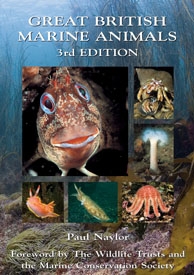 You can see more of Paul Naylor’s work on his website at www.marinephoto.co.uk and in his book Great British Marine Animals.
You can see more of Paul Naylor’s work on his website at www.marinephoto.co.uk and in his book Great British Marine Animals.
This book is highly recommended by MARINET.




